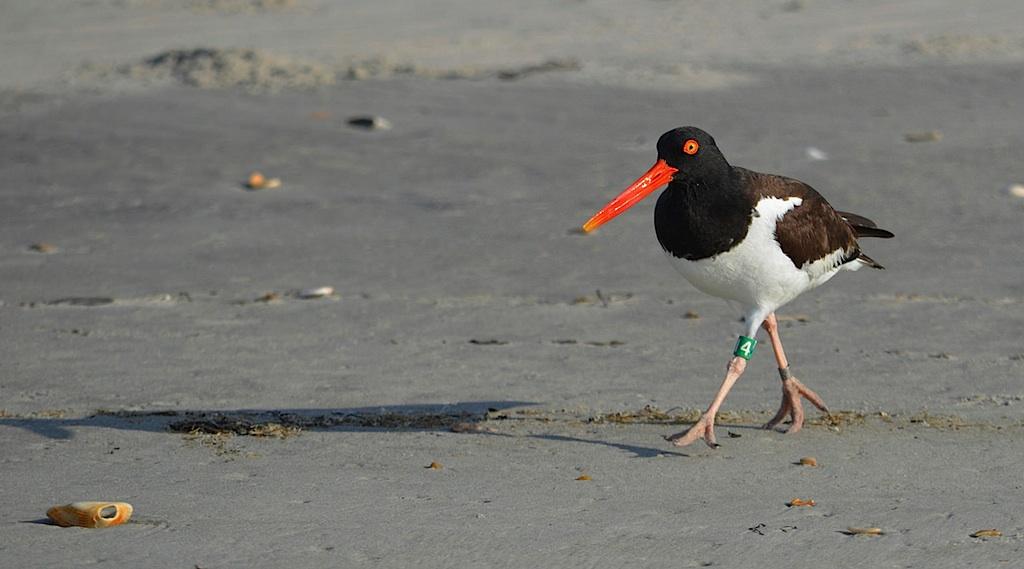This American oystercatcher, not-so-affectionately known as Gr14, has reared 9 chicks at Cape Hatteras National Seashore over the past decade.
Speak Softly And Carry....A Big Beak!

Support Journalism about National Parks!
National Parks Traveler is a 501(c)(3) nonprofit.
The Essential RVing Guide

The National Parks RVing Guide, aka the Essential RVing Guide To The National Parks, is the definitive guide for RVers seeking information on campgrounds in the National Park System where they can park their rigs. It's available for free for both iPhones and Android models.
This app is packed with RVing specific details on more than 250 campgrounds in more than 70 parks.
You'll also find stories about RVing in the parks, some tips if you've just recently turned into an RVer, and some planning suggestions. A bonus that wasn't in the previous eBook or PDF versions of this guide are feeds of Traveler content: you'll find our latest stories as well as our most recent podcasts just a click away.
So whether you have an iPhone or an Android, download this app and start exploring the campgrounds in the National Park System where you can park your rig.


If you go to the Hatteras website and use the Park Alerts section, you can download a map from Google Earth that graphically shows open and closed areas of the seashore.
You will also find monthly listings of open and closed areas. A little homework will show that many of Dumb's claims are exaggerations at best.
Yes, several miles are closed right now. But how many are OPEN? And how long will it be before the closed areas are opened again when the birds or turtles or whatever no longer need protection? His claim that there is no beneficial impact is certainly open to question.
Then there are large sections of the beaches that are either not included in the seashore's boundaries or are inholdings (private land located inside the seashore) where travel may be banned by the owners. Those areas will open to public use if the NPS is able at some time to purchase them.
May I suggest that before taking any sides in this argument, people should do some research using sites that contain actual information and not opinion or emotion.
I admit that I'm not personally familiar with Hatteras, so if anyone finds errors in anything I've posted please let us know. Just back it up with facts.
EDIT.. Posted this before reading Kurts post above.
-------------
I want to see scientific documents that are peer reviewed from biologists that state the management plan has had no beneficial impact. Not just empty rhetoric because someone can't use an ORV while birds nest on a beach.
Birds can leave a nest if they are harassed. That's common knowledge. You want to call people dumb, then post the scientific peer-reviewed articles that back up your claim. Otherwise it's just empty rhetoric.
Gary,
You requests for documentation is a valid one. One that probably should have been made BEFORE going off on rants about entitlement mentality and the tea party.
I just looked at the Google Earth file. Man, I do find it interesting that the areas that are closed to protect birds are mostly in areas outside of towns in just small 1 mile segments.
I guess the term "remote" is different to everyone. I don't think something that is less than a mile and half from a parking lot is "remote" by any means. I haven't been to this place in 2 decades, but judging from all the pictures on google earth, it is over abused by folks in ORVs.
Ecbuck, i've seen enough from the tea party folks in NC to have a view into "their world". My opinion has validity if you've seen them in action like I have.
And looking at Kurts documents, the Piping Plover shows that the nesting populations have increased since the closures. And some of the documents show that people still disregard the rules, and use ORV's and walk the beaches regardless of the rules in place. Typical.
According to the reports for 2012 and 2013, nesting pairs of piping plovers have dropped somewhat significantly. While there were 15 breedings pairs in 2012 that produced 22 nests, there were just nine in 2013 that produced nine nests.
And while some humans have disregarded the rules, predation and storms also are factors in losses.
My family tradition of walking skyclad [clothed only in sunlight] has been intruded upon by the authorities. We have been told that we cannot return to Main Street for our traditional naked walks. We harm no one.
And, unfortunately, that is a part of being a member of a group, dating all the way back to hunter/gatherers --- some compromises have to be made, some boundaries, some folks are no longer allowed to swing their fist when the noses of others are in their way.